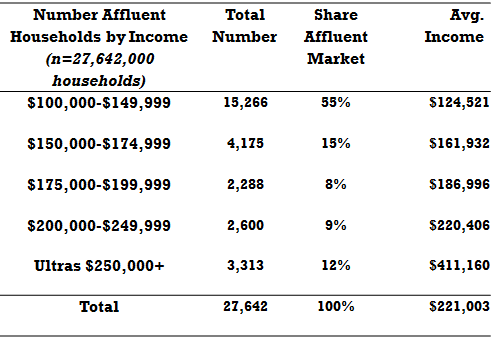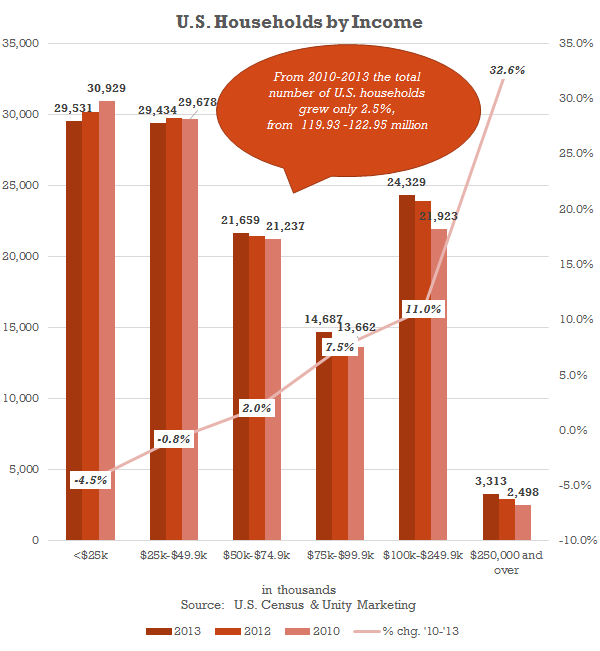Unity Marketing's look at the five most important trends for marketers targeting the U.S. affluent customer in 2015
 The United States affluent consumer has never been more important to luxury brands worldwide. While the BRIC developing country markets for luxury (i.e. Brazil, Russia, India, China) grab all the headlines, the United States is by every measure the market that counts the most. The U.S. has eleven times more millionaires than China -- 11.53 million in 2013 according to the Federal Reserve Board vs. 1 million in China, as reported by Shanghai-based Hurun Research Institute.
The United States affluent consumer has never been more important to luxury brands worldwide. While the BRIC developing country markets for luxury (i.e. Brazil, Russia, India, China) grab all the headlines, the United States is by every measure the market that counts the most. The U.S. has eleven times more millionaires than China -- 11.53 million in 2013 according to the Federal Reserve Board vs. 1 million in China, as reported by Shanghai-based Hurun Research Institute.
Those U.S. millionaires and other high-income customers pump more money into the coffers of luxury brands, as well. Bain/Altagamma, in their study of the worldwide luxury market, put the U.S. luxury market size at €62,5 billion in 2013, nearly 3.5 times larger than the next largest market, Japan.
But, while wealth and spending power worldwide is concentrated with the U.S. consumers, the affluent don't really feel all that well-off, which puts the brakes on extravagant spending that luxury often represents. When it comes to consumer purchases, how the affluents feel about their wealth, not what the data on their financial balance sheet reports, is most important. Today, those with household incomes of $250,000, which means they are doing better than nearly 98% of all U.S. households, feel middle-class and spend like it. They certainly don't feel luxury class.
American's emerging attitude toward wealth and affluence has disrupted the traditional model for luxury brand marketing in the United States. That traditional luxury model, based upon status, exclusivity, elitism and conspicuous consumption doesn't play well anymore to the U.S. affluents, whereas it works quite well in other cultures.
This is the first trend that is most profoundly shaping the future of the U.S. luxury market -- Affluent Austerity -- and giving rise to the four others of critical importance:
- Luxury has a brand new style, which affluents express in new ways, which means,
- Luxury brands must tell a new story that resonates with affluent's new values.
- Affluents, especially the highest-income ultra-affluents, are shopping in new ways.
- Millennials on the road to affluence will gain traction and bring new expectations and experiences into the luxury market.
Stay tuned to the blog for more on these upcoming trends!
TREND #1: Affluent Austerity Is Shaping the Future of Luxury in U.S.A
Today affluent consumers with plenty of cash on hand are being more selective, more pragmatic, more demanding and much more careful about what luxuries they buy and how much they spend.
Affluents at the top 20% of the nation’s income pyramid are spooked about the economy. The result: They are trading down to less premium brands, as well as forgoing extra expenditures and indulgences.
While the upper-income consumers have largely recovered from the recession and have a good handle on their financial status, they are still holding back when it comes to spending. Simplicity, back-to-basics, retreat & downscaling is the mood.
Who are the Affluent?
Unity Marketing defines the affluent as those at the top 20% of U.S. households based on income and today's post-recession economy, that starts just a shade above $100,000. All told, there are 27.6 million affluent households, and their average income is $221.0k, according to the latest figures from the Census Bureau. But, that group is divided into two segments by income:
- HENRYs (High Earners Not Rich Yet) or the mass-affluent with incomes $100,000-$249,999. HENRYs number some 24.3 million households.
- Ultra-affluents with incomes $250,000 and above, which account for 3.3 million households. Their average is $411,160.

Further, the latest statistics show that the affluent segment of the population is growing faster than any other since 2010. And, the ultra-affluent segment is growing fastest of all. Since 2010, the number of ultra-affluent households grew by roughly 33%, while the total number of households rose only 2.5%.

Not only are the affluents growing fastest overall, their influence on the consumer economy is two-times larger than their relative size. While they make up only 20% of the total households, the affluents account for more than 40% of total consumer spending, as reported by the Labor Department's Consumer Expenditure Survey. Net/Net: The affluents are twice as important to any marketer that sells consumer goods and services. These are the most financially empowered customers and the one's that count most to every marketer, from mass to 'luxury class.'
The trend toward austerity is brought about by the values and spending practices of the affluents.
Overwhelmingly, the affluents worked hard to accumulate their wealth and financial status and aren't about to let indulgent spending and giving into consumer temptation threaten that status. As a group they hold leadership positions in business and their professions. They are the best-informed customers, aware of what's happening on Wall Street, as well as 'main street.' They follow economic trends, government policies and trends impacting business. Financial security is a primary concern.
So, for example, the affluent, especially the ultra-affluents, are following the income inequality debate and how public opinion is increasingly demonizing them and their wealth. As a result, inconspicuous consumption is taking hold and giving rise to new luxury brands that reflect this new expression.
Here is a final note to those skeptics that believe the affluent consumers are going to bounce back as indulgent as ever, to those that believe the current trend toward austerity just reflects a normal business cycle that will play itself out. Perhaps this is true, but the simple fact is that today's affluent consumers in 2015 will be 7 years older than they were back in 2008 when the recession and the financial crisis hit. Unity Marketing's tracking of affluent consumer expenditures over the last 10+ years has shown that the younger affluents (24-44 years) spent twice as much on luxury than the older affluents (45-70 years). Older affluents have already acquired plenty of stuff, and they tend to downscale their lifestyles as children leave the nest, all the while shifting spending toward experiences. Those 7 years from 2008-2015 represents nearly 20% of a typical adult's consumer lifecycle, while the 41 years from age 24-65 when retirement shifts people's consumer expenditures completely in new directions.
During the intervening years since the recession, affluents have brought new values and expectations into their consuming lifestyle. Marketers have responded with new brands, new ways of marketing, new shopping experiences. These trends will only continue to disrupt the traditional business of luxury marketing in the USA in 2015 and beyond, especially as millennials, the up and coming new generation for luxury, mature in their careers and rise in affluence.
To learn more about the trends, download Pam Danziger's free white paper, Five Luxe Trends for 2015, and stay tuned as we highlight more trends on the blog.
Editor's Note:
This post was written by Pam Danziger, President of Unity Marketing.
About Unity Marketing
Drawing upon their extensive industry experience, as well as professional expertise in marketing research and analysis, product and concept development, strategic planning and licensing, Unity Marketing offers marketing research that helps clients identify and maximize their potential success in the collectibles and giftware markets. Unity Marketing utilizes a full range of quantitative and qualitative research to address its clients' marketing challenges.


